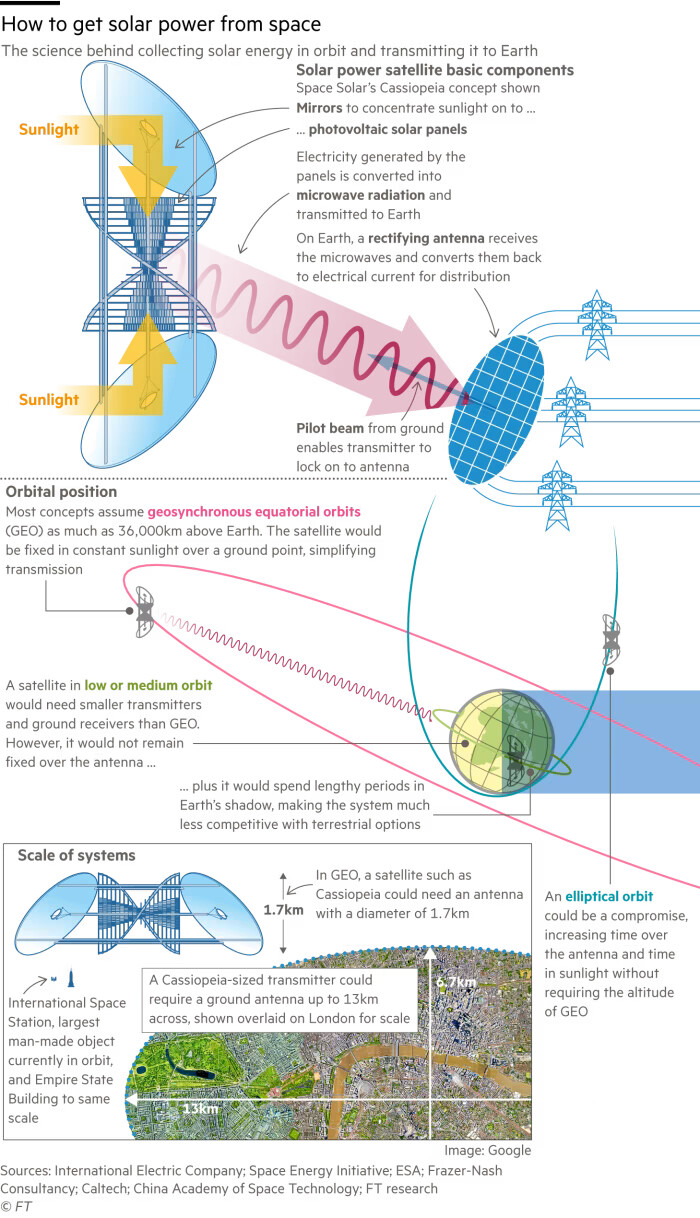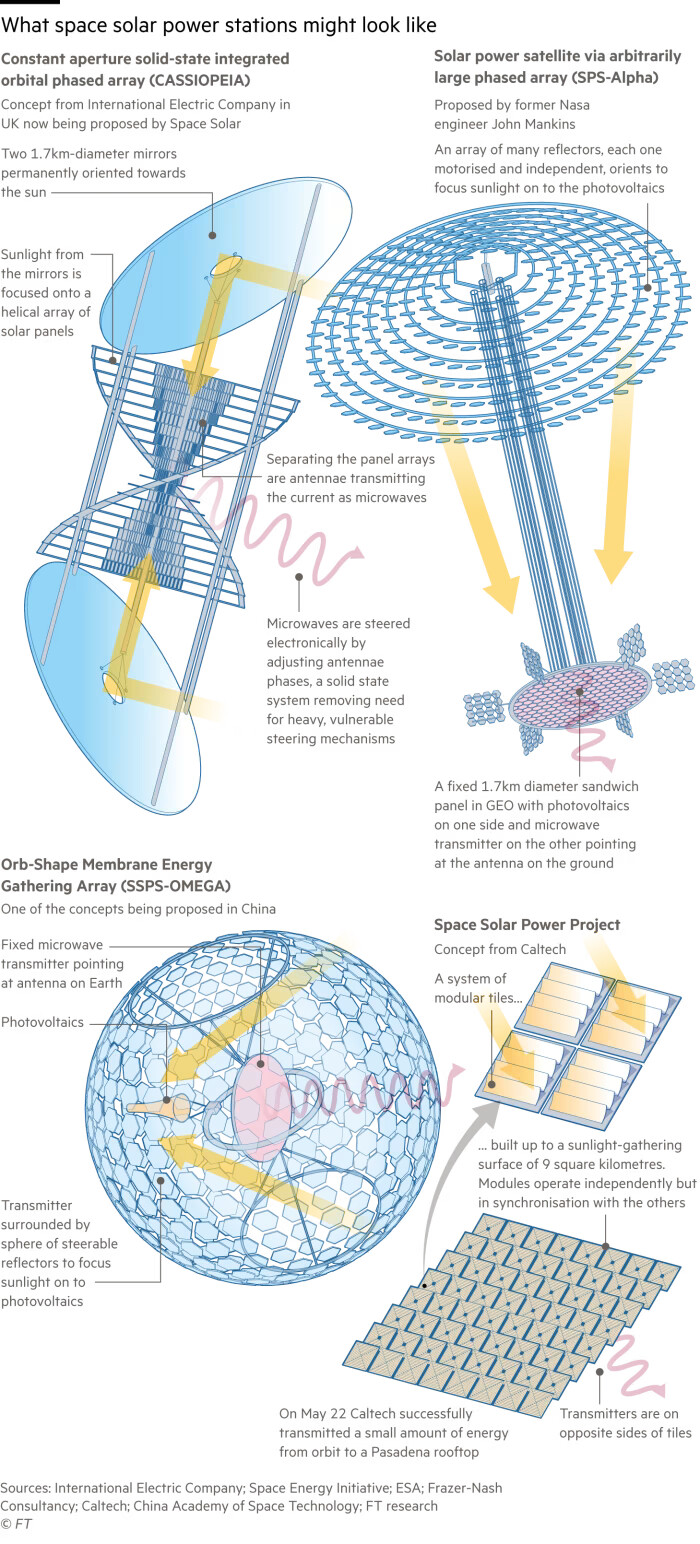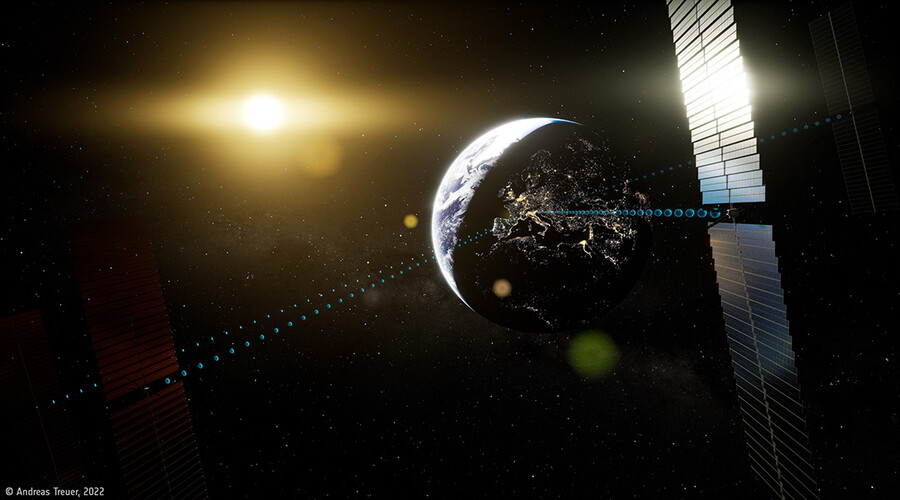파이낸셜 타임스 기사 요약 (ChatGPT)
우주 태양광 발전(Space-based solar power, SBSP)은 기후 변화 문제를 해결하고 지속 가능한 에너지원을 제공하기 위한 잠재적 해결책으로 주목받고 있습니다. SBSP는 우주에서 태양 에너지를 수집하고 무선으로 지상으로 전송하는 기술입니다.
SBSP를 현실화하기 위한 핵심 사항은 다음과 같습니다.
기술적 타당성: 우주로부터 지상으로 태양광을 무선 전송하는 기술이 성공적으로 시험되어 SBSP의 기술적 타당성이 입증되었습니다. 이 기술은 태양이 항상 빛나는 우주에 위성을 배치하고 위성에 부착된 태양 전지로 태양 에너지를 전자파로 변환한 후 지상으로 전송하여 전기로 변환하는 방식으로 작동합니다.
경제적 타당성: 위성 기술의 발전과 비용 효율적인 발사 방법으로 인해 SBSP의 경제성은 최근 몇 년 동안 크게 향상되었습니다. 최초의 2GW 우주 태양광 발전소를 개발 및 배치하는 비용은 기존 에너지원인 핵 에너지보다 훨씬 낮을 것으로 추정됩니다.
환경적 혜택: SBSP는 상당한 양의 깨끗하고 지속적인 에너지를 제공할 수 있습니다. SBSP는 탄소 배출량을 줄이고 화석 연료에 대한 의존도를 낮출 수 있습니다. 에너지는 지상의 여러 위치로 전송할 수 있으므로 매우 다양하게 활용할 수 있습니다.
도전과제 및 우려 사항: SBSP는 잠재력이 있지만 몇 가지 도전과제 및 우려 사항이 해결되어야 합니다. 이러한 과제 및 우려 사항에는 시스템의 대규모, 인간과 야생 동물의 안전 문제, 잠재적인 공격 취약성 및 궤도 내 혼잡과 관련된 문제가 포함됩니다.
대중의 수용: SBSP를 성공적으로 구현하기 위해서는 대중의 수용이 필수적입니다. 안전 문제에 대한 해결, 환경 영향에 대한 연구 및 에너지 및 유틸리티 부문의 참여는 지지를 얻기 위한 중요한 단계입니다.
국제 협력: SBSP 기술이 발전함에 따라 우주 혼잡, 접근성 공평성 (기술이 뒤쳐진 국가에 대한 접근성 보장) 및 보안 문제를 해결하기 위해 국제 협력과 거버넌스가 필요할 수 있습니다.
결론적으로, 우주 태양광 발전은 기후 변화 문제를 해결하고 지속 가능한 에너지를 제공하기 위한 잠재적 해결책으로 과학 소설에서 벗어나 현실화되고 있습니다. 극복해야 할 과제가 있지만 기술적 타당성과 경제적 타당성으로 인해 더 깨끗하고 안정적인 에너지 미래를 위한 매력적인 옵션이 되었습니다.
===============================================
Concerns over climate change are fuelling breakthroughs in satellite technology that harnesses the sun’s energy

Space-based solar power was once seen as science fiction, but governments around the world are reconsidering its potential © FT montage/Ian Bott
Peggy Hollinger 7 hours ago
The young researchers gathered on the rooftop of Caltech’s engineering laboratory in Pasadena on a balmy May evening did not set out to make history that night.
But after a long day setting up equipment to test a solar power satellite, the professor leading the project told them to grab something to eat and come back.
“It was close to 10pm and we said, ‘Let’s have a go. Let’s do a dry run,’” says Ali Hajimiri, professor of electrical engineering at the California Institute of Technology. “At first we thought we weren’t detecting a signal. Then it started coming in and getting stronger.”
The team was elated. For the first time, a detectable amount of solar power had been beamed wirelessly from space back to Earth. No matter that it was insufficient to power even a lightbulb. It was proof to a growing community of space solar power advocates that it was technically possible to supply a power-hungry planet with energy from space.
“The sun is the closest thing we have to an infinite energy source,” says Paul Jaffe, an electronics engineer at the US Naval Research Laboratory who has studied space-based solar power for 16 years. “You [could] create a global energy network that could provide energy potentially anywhere on Earth. Space solar could do for energy what GPS did for navigation.”
Space solar power was first mooted by science fiction writer Isaac Asimov in his 1941 short story “Reason”. In reality, however, it has long been dismissed as too costly and technologically challenging to be commercially viable. But as the sense of urgency over the threat of climate change grows and the economics of space evolve, governments around the world are reconsidering its potential. Researchers in China, the US, UK, Japan and Europe are all studying its feasibility, with a view to possibly launching experiments into space before the end of the decade.
China’s ZhuRi programme — translated as “chase the sun” — has plans to put a pilot power plant into orbit generating 20 megawatts of power by 2035. In the UK, a group of entrepreneurs behind government-backed start-up Space Solar are even more ambitious. They aim to build a gigawatt scale power plant in space by the same date, scaling up to a fleet of plants delivering 30 gigawatts into the energy grid by the 2040s. And though Caltech’s experiments have been funded by billionaire philanthropist Donald Bren rather than the government, the US Air Force Research Laboratory is planning a power-beaming demonstrator from low Earth orbit in 2025.
Many proponents of space-based solar power (SBSP) believe the technology has greater potential than nuclear fusion to help the world meet its net zero targets.
“All of the physics [of space-based solar power] have been demonstrated, tested, and verified,” says John Mankins, a former Nasa physicist whose work on SBSP over more than 25 years has earned him the sobriquet “godfather of space solar power”.
Although US scientists claimed to have achieved a net energy gain in a fusion reaction last year, the process “is still some years away from demonstrating that the system would generate more energy than you have to put into it,” he says.
With sufficient investment, adds Sanjay Vijendran, who leads the European Space Agency’s Solaris project, “space solar power could be available sooner than fusion”.
How it works
Harvesting the sun’s energy is achieved by attaching solar panels to a satellite flying thousands of miles above the Earth’s surface, in constant sunlight. This energy is then converted into microwaves, which are beamed through the atmosphere to a receiving antenna, where they are reconverted into electricity to be distributed through the grid.

Diagram explaining the basic principles and components of space-based solar power systems
정지궤도(geostationary orbit, geosynchronous equatorial orbit, GEO)
→ 위도 0°인 적도 36000 km 상공의 원형 궤도
A single satellite could potentially deliver as much as 2GW of carbon-free power, enough to supply a city of 2mn people, 24 hours a day, seven days a week.
Thales Alenia Space, the Franco-Italian space infrastructure company, is studying the potential emissions savings that could be made with space solar power. With a working life of 25 to 30 years per solar power station, the lifetime carbon emissions savings could be “hundreds of millions of tonnes”, says Massimo Comparini, TAS deputy chief executive.
This is not the first time that nations have looked to the skies to solve Earth’s energy emergencies. In 1976, prompted by soaring energy costs after the oil embargo, the US Department of Energy launched a four-year study of space solar power. The conclusion then, and for several decades afterwards in subsequent studies, was that obtaining power supplied from space would be prohibitively expensive.
But in the past decade there has been a revolution in the economics of satellite-generated solar power, says Mankins. Thanks to SpaceX’s reusable Falcon rocket, “there’s been a 90 to 95 per cent reduction in the cost of launch”. The prospect of SpaceX’s gigantic Starship, currently in development and with the ability to lift more than 100 tonnes into orbit, promises to take costs down even further.
The introduction of factory processes for satellites — traditionally manufactured in rarefied “massive operating theatre clean rooms” — has helped cut the costs of producing them by a similar order, he adds. “These are essential pieces of the puzzle for why space solar power can go forward now,” Mankins says. “Even as recently as 10 years ago, this idea was still not economically feasible.”
In 2020 the UK government commissioned a study on the economic and technological feasibility of space solar power. The study concluded that the total cost to develop and deploy the first 2GW space-based solar power station would be roughly £16bn — substantially less than the latest £33bn estimate for Britain’s newest nuclear power station at Hinkley Point, which is set to produce 3.2GW. Once the first solar station was up and running, subsequent power generating satellites would cost less than £4bn each, the study estimated.
Oxfordshire-based Space Solar estimates that a solar power-generating satellite would produce energy at a cost of just $34 per megawatt hour by 2040 to break even over its lifetime, against $43 per MWh for a large terrestrial solar farm, $53 per MWh for offshore wind, and $125 per MWh for nuclear.
“The economics work out really well and this really could be transformative,” says Martin Soltau, who led the UK study by consultants Frazer-Nash before founding and becoming co-chief executive of Space Solar.
Formidable challenges
But there are many who believe space-based solar power still belongs in the realms of science fiction. SpaceX founder Elon Musk once called the concept the “stupidest idea ever”. His argument was that heavy energy losses during conversion from sunlight to electricity made space solar power much less efficient and so uncompetitive with solar farms on Earth.
Harry Atwater, one of the three Caltech professors leading the university’s Space Solar Power Project and an expert in photovoltaics, disagrees.
“Going from sunlight in space to electricity on Earth would be about 5-12 per cent efficient,” he says — meaning up to 95 per cent of the energy would be lost. But the amount of sunlight in space in a 24-hour period “is a factor of eight higher than it is on Earth.” (5% × 8 = 40%)
“It would be similar to having a 40 per cent efficient [solar] cell on Earth. We don’t have any of those. People are aiming now to just get to 30 per cent — maybe.”

Diagram outlining some of the current concepts being studied for solar power satellites
Space solar power’s second big advantage is that the microwave beam can be directed to multiple locations — anywhere with the appropriate receiving antenna. “From space we have line of sight to a lot of places,” says Caltech’s Hajimiri. That dispatchability could open up a new global market in carbon-free energy.
Solar power from space is also available continuously, whereas terrestrial renewables such as wind or solar power can’t generate power when there is no wind or sun. These systems require storage to supply power in the down times, and extra capacity to replenish the storage and satisfy user demand when conditions allow. That pushes up the cost. “You have paid for the energy twice,” Soltau says. “You have paid for wind and solar systems but also had to pay for back-up.”
While space solar power’s advocates believe the technology is on the brink of proving its utility, there are still substantial obstacles to making Asimov’s vision a reality.
The scale of the system remains an enormous challenge, both in space and on Earth. Each satellite has to be huge — 1.5km across or more — if it is to beam power accurately to a specific location. The receiving antenna, a mesh of thousands of small receivers, will be multiples bigger — perhaps several kilometres in diameter — to capture the diffused microwaves as they hit the Earth.
The space-based systems will use modular components, to simplify construction and contain costs. But they would have to be assembled by autonomous robots. Caltech’s model is an exception, using hundreds of independent lightweight panels of solar cells that would fly in formation, like a “murmuration of starlings”, says Atwater.
Structures of this scale have never been built or deployed in space. The International Space Station is the largest object humans have ever put into orbit — and it comes in at just over 100 metres long.
Building the receiving antenna may not be as difficult as building the satellite, but the space it would require could prompt objections. And there is certain to be public concern over safety for humans and wildlife.
The concept of space-based solar power has gained interest despite its challenges. However, many remain sceptical that it will ever be more practical than Earth-based energy production © ESA/A Treuer
Experts in space solar power say these concerns can be assuaged. They insist that power transmission can be done safely via a low frequency and longer wavelength. “The wavelength is about 12 centimetres,” says Mankins. “It’s not capable of breaking the bonds between the atoms that make up DNA and therefore it cannot be carcinogenic.”
Even at the most concentrated area of the receiving antenna, the microwave intensity would be “about a quarter of full summer sun. It’s far less intense than sunlight,” he adds.
Nasa studies on starlings have shown there is little threat to wildlife, says Soltau. But such studies will have to be updated if the system is to win public acceptance. “We fully expect it will be a big challenge — like nuclear or wind farms — to convince people to have this in their backyard,” says ESA’s Vijendran. “That may be the largest challenge of all.” Some projects propose attaching the receiving antenna to offshore wind farms, where grid connections already exist, to help to dampen public concerns.
Putting such massive power generators in space also raises questions about vulnerability to attack. “Do we really want to put our energy grid directly into . . . a war zone if a major conflict spills over into space,” asks Bleddyn Bowen, author of Original Sin: Power, Technology and War in Outer Space and associate professor of international relations at the University of Leicester. “There are huge political and security challenges that no one is talking about.”
Peter Garretson, the US Air Force’s former chief of future technology and author of Scramble for the Skies: the Great Power Competition to Control the Resources of Outer Space, does not believe this is a reason to abandon space solar power.
“Name me an energy system that is not vulnerable,” he says. “Oil is always at mercy of international trade flows. Gas is at the mercy of the power that controls it and the length of pipeline or shipping. There is no energy system that is not vulnerable.”
He also dismisses suggestions that a solar power satellite could be used as a weapon. “The best it can do is provide about a fifth the intensity of sunlight, barely enough to warm a candy bar,” he says.
Yet there will be military implications. “With the ability to build a solar power satellite comes an ability to field a military space force that is orders of magnitude more capable than any space force that exists today,” he says. Given the security and governance concerns, “it’s unlikely that solar power would only be the property [of] and controlled by one nation”, he adds.
Others point to the growing problem of congestion in orbit. While space is a big place, fleets of kilometre-scale satellites even in geostationary orbit 36,000km above the Earth could pose new risks, such as a cascade of collisions that could render certain orbits unusable.
It is also unclear how these vast solar farms would be regulated and whether there would be any orbital slots left open for countries as yet unable to consider such a complex and expensive undertaking. “Will it be first come, first served?” asks Bowen. “There are real equity issues there in global governance.”
Energy mix
Space solar power is for now the preserve of researchers. But as environmental pressures mount, some investors are beginning to take the technology more seriously.
The UK government is in talks with Saudi Arabia about investing in space-based solar power through collaboration with Space Solar, which is in the process of raising funds.
But without buy-in from the energy and utility sectors that distribute power to end users, space-based solar power will remain a pipe dream. “This has to be driven as an energy project that has a large space element,” says Vijendran. “We are trying to have [the energy sector] take it over as soon as possible.”
That is why the European Space Agency study includes companies such as Italy’s Enel and France’s Engie. In the UK, EDF is studying the technology’s potential for the country’s innovation agency. But generally, energy companies are still in wait-and-see mode.
“There are still some significant question marks over this — like, is it actually possible to build and operate and launch this system?” says David Ferguson, head of net zero research at EDF UK. “There is a lot that still needs to be proven from a technical point of view.”
As with renewables and the need for extra storage, there are also hidden costs to a space solar power system. EDF’s researchers estimate that “space weather” — factors such as solar flares, geomagnetic storms and radiation — could degrade satellites faster than expected. That would add about £2-£7 to the cost per kilowatt hour. “We think there is a roughly 20 per cent loss of productivity over the lifetime of the system, due to space weather,” says Ben Cayless, EDF renewables engineer.
Nevertheless, EDF, like Enel and Engie, is not quite prepared to ignore the potential of a new source of clean power. “Our strategy is not going to change based on this work or in the short term,” says Cayless.
“But most companies are like us. We are looking at it and keeping our options open.”



